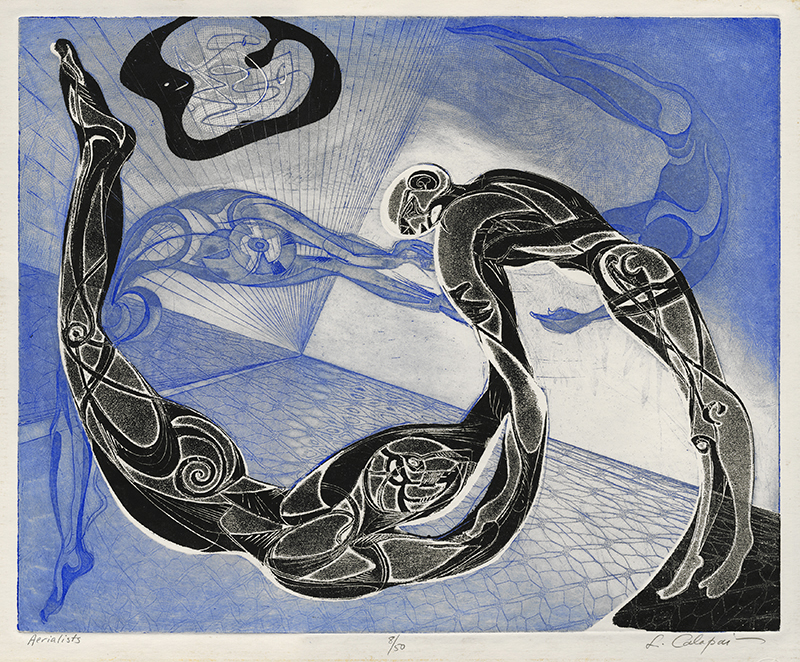Aerialists is a mixed technique color intaglio from 1949 by American artist Letterio Calapai. For his image, the artist combined aquatint, collagraph, and etching and there are over twelve different and distinct variations. Aerialists is pencil signed, titled and editioned 8/50. It was printed by the artist on ivory BFK Rives wove paper and it bears the artist’s blindstamp in the lower right margin. The platemark measures 13-1/2 x 16-13/16 inches.
In his introduction for Letterio Calapai: A 50 Year Retrospective (1934-1984), Alfred P. Maurice wrote: Calapai went on to gain equal mastery of the intaglio processes of etching, dry point, aquatint and collagraphy and to invent variations which further extended the range of his printmaking techniques. He is a master printer as well as maker of prints….At the level of technique, Calapai is in the first rank of artists working in printmaking today. But, he does not use this expertise to dazzle us with rhetorical exercises. Instead, we find in all his prints thoughtful orchestrations of techniques to enhance the meaning and expressiveness of his imagery.
Letterio Calapai, painter, printmaker, illustrator, and teacher, was born in Boston, Massachusetts on March 29, 1901. Following his graduation from the Massachusetts Normal Art School (now the Massachusetts College of Art) in 1925, he was awarded a two-year scholarship to the School of Fine Arts and Crafts in Boston where he worked under Charles Hopkinson and Howard Giles. In 1928, Calapai moved to New York to continue his studies, taking sculpture at the Beaux Art Institute of Design, figure drawing with Robert Laurent at the Art Students’ League, and the techniques of fresco painting with Ben Shahn at the American Artists School. His first solo exhibition was at the Art Center in New York City in 1933.
As a muralist, Calapai painted a mural about 1937 for the WPA entitled The Evolution of Communications in American Wars, which was painted for the 101st Battalion Signal Corps in Brooklyn, New York. He also created several murals for the 1939 New York World’s Fair.
Calapai worked at Stanley William Hayter's Atelier 17 in New York between 1946 and 1949, eventually becoming Hayter's assistant. Following this, with Hayter’s recommendation and at the behest of Philip Clarkson Elliott, he was hired to establish the printmaking department at the Albright Art School. He was chairman for six years, during which time the school transitioned to become the University of Buffalo. He returned to New York City in 1955, and in 1959 he received a Tiffany Foundation Grant, allowing him to establish the Intaglio Workshop for Advanced Printmaking in Greenwich Village. Calapai also taught at the New School for Social Research, New York University, and Brandeis University. He moved to Chicago in 1965 and, as visiting Associate Professor, taught at Kendall College, Evanston. The following year, Calapai was asked to teach the summer session of graphics at the University of Illinois, Chicago.
Calapai illustrated a variety of literary works centering on sociopolitical and religious themes. Among them were Lorenz Graham's How God Fix Jonah, 1946, with a foreword by W.E.B. DuBois; a portfolio of woodcuts based on Thomas Wolfe's novel Look Homeward Angel, 1948; and The Negro Bible Series, 1946, republished by Cornel West in 1992.
The work of Letterio Calapai is included in the collections of the Allentown Art Museum; the Baltimore Museum of Art; the Museum of Fine Arts Boston; the Brooklyn Museum, New York; the Art Institute of Chicago; the Amon Carter Museum of American Art, Fort Worth; the Indianapolis Museum of Art; the National Bezalel Museum, Jerusalem; the British Museum, London; the Brooks Museum of Art, Memphis; the Milwaukee Art Museum; the David Owsley Museum of Art, Muncie; the Metropolitan Museum of Art and the Museum of Modern Art, New York; la Bibliothèque nationale de France, Paris; the Philadelphia Museum of Art; the McNay Art Museum, San Antonio; the Fine Arts Museums of San Francisco; the Kemper Art Museum, St. Louis; the Sydney Art Museum, Australia; the Georgetown University Library, the Library of Congress, and the National Gallery of Art, Washington, D.C.; and the Delaware Art Museum, Wilmington.
Letterio Calapai died in Glencoe, Illinois on
his ninety-second birthday, March 29, 1993.



